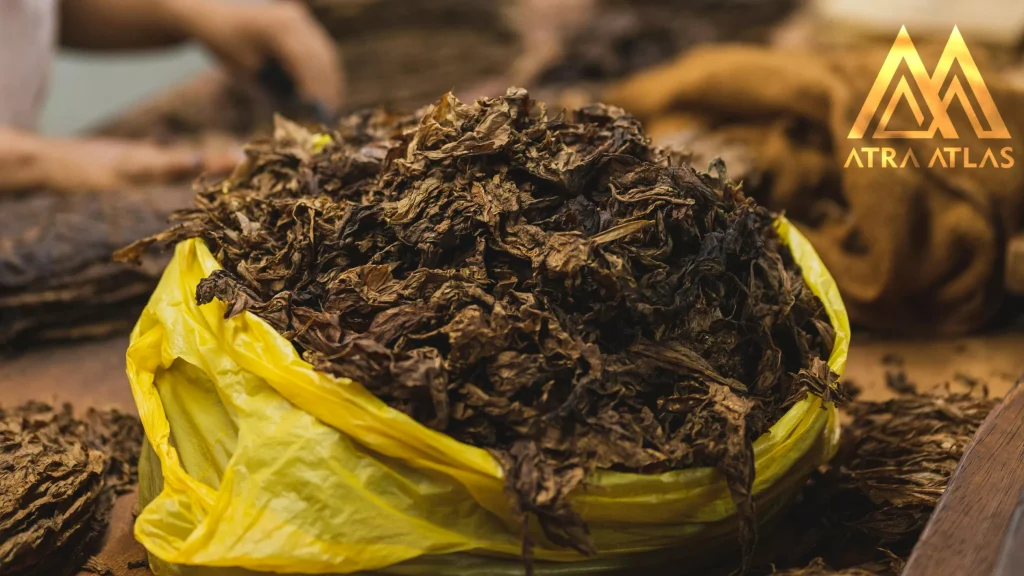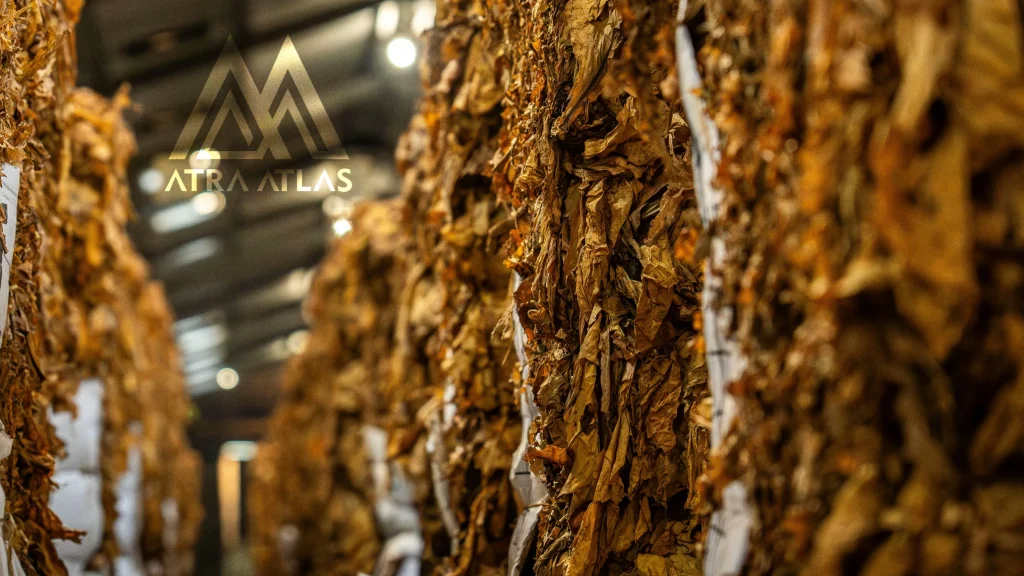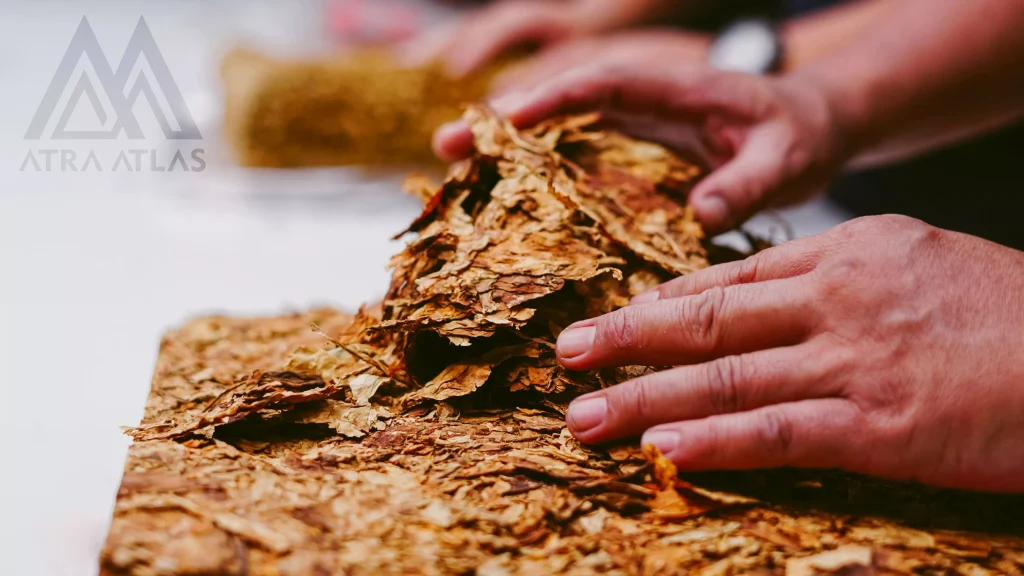
Tobacco
Tobacco: A Plant of Global Value
Tobacco or Nicotiana is a plant with broad leaves that originally grew in North and South America and is now cultivated worldwide. The term tobacco also refers to the dried and cut leaves of this plant. The primary use of this plant is for smoking the smoke produced by burning its dried leaves, which contain nicotine. This is done by rolling it in paper or wrapping the uncut leaves into cigarettes or cigars and placing them in the head of a hookah and smoking them.
History and Discovery of Tobacco
This plant usually grows between 15 to 100 centimeters. Its leaves are large and broad, about half a meter tall, and have a sticky sap. In the late 15th century, after Christopher Columbus discovered the Americas, he learned the method of smoking tobacco from the Indigenous people. For the Indigenous, tobacco was a sacred plant that connected them with the spirit world.
Economic Role of Tobacco
Tobacco significantly contributed to the American economy and found its way to Europe and then to other parts of the world. The alkaloid nicotine is typically recognized as the main component of tobacco, but nicotine alone is not addictive. It appears that the reaction between beta-carbolines and nicotine is responsible for most of the addictive properties of tobacco use. There are more than 70 types of tobacco plants in the Nicotiana family. The word Nicotiana (and nicotine) is named in honor of Jean Nicot, the French ambassador to Portugal, who sent this substance as a medicine to the court of Catherine de’ Medici in 1559.
Brazil and Tobacco Production
Brazil has been the world’s largest exporter of tobacco for 25 years. The main buyers include China, the United States, Italy, and Belgium, purchasing nearly half a million tons annually. Brazil, adhering to the strictest international standards, is the second-largest tobacco producer globally and the leading exporter since 1993, thanks to the quality and integrity of its product. The country produces more than 700,000 tons of tobacco annually.
Economic Importance of Tobacco in Brazil
Tobacco is one of the main products in Brazil’s trade balance and is cultivated in the southern regions of the country. Despite a significant decline in the prevalence of smoking since the 1990s, Brazil has become a major global exporter, selling nearly 90% of its production to other countries. For the southern region of Brazil, tobacco is one of the most important agricultural and industrial activities.
This product is cultivated in 508 different cities in southern Brazil, providing employment for 138,000 small-scale farmers and creating 40,000 direct and indirect industrial jobs.
Primary development of tobacco
Tobacco has been consumed in the Americas since ancient times until European settlers arrived and introduced this experience to Europe, where it became very popular. Many Native American tribes traditionally cultivated and consumed tobacco in fields in Mexico from 1400 to 1000 BC.
Consumption and trade of tobacco in native tribes
Eastern North American tribes carried large amounts of tobacco in bags as an acceptable trade commodity and often smoked it in peace pipes (a type of pipe) during sacred ceremonies or to seal deals. On such occasions, tobacco was smoked at all stages of life, even in childhood. They believed that tobacco was a gift from the Creator, and the exhaled smoke carried the thoughts and prayers of humans to heaven.
Development of tobacco strains
Before the development of Itar Virginia and white Burley strains, tobacco smoke was very harsh, and Native Americans and Europeans who consumed it through pipes or cigarettes couldn’t inhale it into their lungs. Inhaling harsh tobacco smoke without short-term serious damage required smoking small amounts through pipes like a midwakh or a kiseru or newer water pipes like a bong or a hookah.
Impact of tobacco on societies
Tobacco has played a significant role in the lives and economies of various societies from ancient times to today. From religious and cultural uses by Native Americans to becoming a major trade commodity and ultimately, its development and popularity around the world.
Tobacco Popularity: Past to Present
After the arrival of Europeans in America, the popularity of tobacco as a commercial commodity increased. This plant boosted the economy of the southern United States until cotton replaced it. After the American Civil War, changes in tobacco demand and labor led James Bonsack to invent a machine that automated cigarette production. This increase in production caused the rapid growth of the tobacco industry until the scientific discoveries of the mid-20th century.
Conditions for growing and cultivating tobacco
The tobacco we use in cigarettes and enjoy smoking every day must be grown in specific conditions to be high-quality. The best climate for sprouting and cultivating the tobacco plant exists in relatively warm areas with temperatures between 20 to 30 degrees and where the temperature does not exceed 35 degrees during the growing period. This plant should be cultivated in places where it can tolerate a temperature difference of over 10 degrees from planting to harvesting.
Irrigation and quality of tobacco
Proper irrigation also has a significant impact on the final quality of tobacco. Irrigation should be done at regular intervals to ensure that the plant receives enough water, but not in excess. The plant should not be flooded; although excessive irrigation speeds up the plant’s growth, it reduces the nicotine content, making the final tobacco unsuitable for cigarette use.
Soil and color of tobacco leaves
Tobacco can grow in almost all types of soil, and if well maintained, high-quality tobacco can be produced. The final color of the tobacco leaves depends on the color of the soil in which the plant is grown. Lighter soil results in lighter leaves. However, the dark color of industrial cigarette tobacco is also due to another reason besides the type of soil it grows in: chemical additives.

What process does the tobacco leaf go through after picking to be ready for consumption?
We said that the tobacco we smoke in cigarettes is the leaf of the plant; but what we smoke does not resemble the leaf and plant! The tobacco we use in cigarettes undergoes a process to become consumable in cigarettes.
Steps to prepare tobacco leaves
Separating the leaves from the stem:
The tobacco leaves must be carefully separated from their stems after being picked.
Drying the leaves:
The leaves must be dried to become consumable tobacco.
The drying process, if done naturally, takes about two years.
Accelerating the drying process:
To make the tobacco ready faster, they are hung and heated in suitable environments with special care so that the drying process is expedited.
Shredding the leaves:
After the leaves are completely dried, they are shredded and ready for use.
Difference between industrial cigarettes and organic tobacco
One of the fundamental differences between industrial cigarettes and organic tobacco is that in industrial cigarettes, besides the leaf of the tobacco plant which has the main property, other parts of this plant like its stem are also shredded and mixed with the dried leaf. Whereas, organic tobacco has no additives to the shredded leaf of the plant.
What is the difference between industrial cigarettes and hand-rolled cigarettes?
Factory-made cigarettes sold in packs are easily accessible to everyone, but we insist that hand-rolled cigarettes are better and of higher quality! But why?
Purity of tobacco
The most important difference between hand-rolled cigarettes and industrial cigarettes is their purity. In hand-rolled cigarettes, you use high-quality, pure shredded tobacco leaves with no additives, whether chemical or natural. In many industrial cigarettes, various chemical additives such as paraffin, sulfur, artificial color, and preservatives are mixed with the tobacco, which is why industrial cigarettes also have more tar.
Tobacco composition
Additionally, the tobacco in industrial cigarettes does not only include the leaves of the plant; the stems of the plant are also shredded and added, which reduces the quality of your cigarette and changes its taste. Generally, the taste of hand-rolled cigarettes is purer, and their smell is less than that of industrial cigarettes.
Difference between tobacco and tobacco
Tobacco is one of the types of plants that was initially used in North America. This plant has a specific smell due to the presence of an oil called nicotine. This plant is used because it contains amounts of nicotine. When the tobacco leaf burns, the nicotine oil turns into smoke and is absorbed into the body through the lungs. Nicotine causes chemical reactions in the body, leading to alertness and reduced fatigue in individuals.
Both tobacco and tobacco are derived from the Nicotiana plant and are used for smoking, but there are differences between the two:
Tobacco:
Medicinal properties: Tobacco has medicinal properties and is used for some medicinal treatments.
Protein and amino acids: The amount of protein and amino acids in tobacco is higher than in the soybean plant, and its protein is equivalent to casein protein in milk.
Use in hand-rolled cigarettes: Pure and additive-free tobacco is used as organic tobacco for hand-rolled cigarettes.
Tobacco:
Dried leaves: Tobacco is actually the dried leaves of the tobacco plant that, after the drying process, are ready for smoking.
Health hazards: Tobacco has disease-causing properties, and its consumption can lead to cancer, respiratory problems, and serious damage.
Use in industrial cigarettes: In industrial cigarettes, tobacco is mixed with chemical additives such as paraffin and preservatives.
Cigarette industry
As we know, the cigarette industry is one of the most profitable industries worldwide. In any region with a moderate climate, tobacco cultivation can be undertaken, which can bring high income to farmers.
How to use Tobacco
The tobacco plant has broad and singular leaves that are used in the tobacco industry and cigarette production. To use the tobacco plant, first, its leaves are collected and spread on the ground. Then, using sunlight and dry air, the leaves are dried. After drying, the tobacco leaves are shredded in cigarette production factories and turned into cigarettes and distributed worldwide.
Medicinal properties of tobacco
This plant is one of the types of smoking plants that also has some medicinal properties and is used in the treatment of certain diseases. The amount of protein and amino acids in this plant is higher than in the soybean plant, which is why people use it. In general, the protein in tobacco is more than casein protein in milk, and this increases energy in individuals.
Tobacco: A plant with medicinal and protein-boosting properties
We should know that this plant is not only a smoking plant but also has medicinal and protein-boosting properties. These features make tobacco useful not only in the cigarette industry but also in the treatment of certain diseases.
The difference between tobacco and tobacco: what is the tobacco plant?
Tobacco is another smoking plant that many Iranian families use, and they consume it using a device called a hookah. The use of tobacco has been common among people since ancient times, making it popular among individuals. However, due to the adverse effects that tobacco consumption has caused, it has gradually become a harmful plant, leading many people to try to quit smoking.
This plant has disease-causing properties such as cancer, which have led it to become widely known among international communities. The consumption of this plant can endanger people’s health and cause severe respiratory problems.
Properties of tobacco
As explained, tobacco is a plant that also has medicinal properties, and due to the proteins it contains, it is considered one of the medicinal substances and has medicinal and therapeutic uses. This has led researchers to use this plant for treating some diseases.
Difference between tobacco and tobacco
Tobacco is actually the dried leaf of the tobacco plant, which does not have medicinal properties and is only used as a smoking substance. It also contains nicotine and can deliver the required nicotine to individuals’ bodies. Tobacco is one of the major causes of serious harm and dangerous diseases such as lung cancer and even mouth cancer. Unfortunately, despite all the harm it causes, even individuals under the age of 15 are inclined to use it.

Tobacco Cultivation: From Cultivation to Preparation
There are many methods for cultivating this plant, but all tobacco plants require intensive care to produce high-quality plants.
Steps to cultivate tobacco
Preparing tobacco seeds:
Tobacco seeds must be mixed with fertilizer, cornmeal, and cotton before planting.
In warm areas, the seeds are covered with cotton cloth, but in cold areas, this is done with fiberglass.
Initial growth of the plant:
In most mountainous areas with moderate humidity, the plant grows about 20 centimeters in 6 to 10 weeks, and during this time, 4 to 6 leaves appear on the seedling.
At this stage, the plant is ready to be transferred to fields that have been carefully prepared and fertilized.
Topping the plants:
When the plants start flowering, the top of each is cut off to make the leaves thicker and darker.
The plant is ready for harvesting 3 to 4 months after placing the seedling in the field.
Harvesting methods:
Picking ripe leaves: In this method, each leaf is picked individually. 2 to 4 leaves are picked from one plant every week, taking 5 to 8 weeks.
Cutting the stem: In this method, after the leaves grow large, the plant is cut from the stem.
Curing tobacco:
After harvesting, tobacco must be cured. The purpose is to dry the leaves and create their true color.
Curing can be done by heat, air, or sun.
Curing with heat: The green leaves are hung in a small insulated hay barn heated by steam.
Curing with air: This method is useful for leaves harvested by the stem-cutting method, which need to be exposed to air.
Curing with the sun: Other types of tobacco are cured by sunlight by hanging them in the sun.
Final stage (aging the leaves):
The final stage, known as aging, involves caring for the cured leaves to mature them and improve their flavor.
Types of Brazilian Tobacco
Types of Tobacco: Production Process and Classification
Companies affiliated with SindiTabaco in southern Brazil produce tobacco leaves of the Nicotianatabacum species, which undergo a natural or artificial curing process and are used for cigarettes, shredding, and other purposes. The tobacco produced in the three southern states of Brazil is divided into two groups:
Air-cured Tobacco
The leaves of these species are dried in warehouses with natural ventilation, and their preparation process takes about 40 days. In southern Brazil, two species from this group are obtained:
Burley: Dark-colored and accounts for approximately 14% of Brazil’s total tobacco volume.
Galpão Comum: Dark-colored and accounts for about 1% of Brazil’s total tobacco volume.
Heat-cured Tobacco
This group includes light-colored tobacco leaves that are cured in barns under controlled temperature and humidity levels, completing in five to seven days. This group includes all Virginia species, which account for 85% of the production volume in Brazil.
The tobacco produced in Brazil adheres to the strictest international standards, boasting high quality and a prominent position in global markets due to its excellence and uniformity.
Conclusion
In case of a request for the export of this product from Brazil, you can contact our colleagues at Atra Atlas Trading Company.
